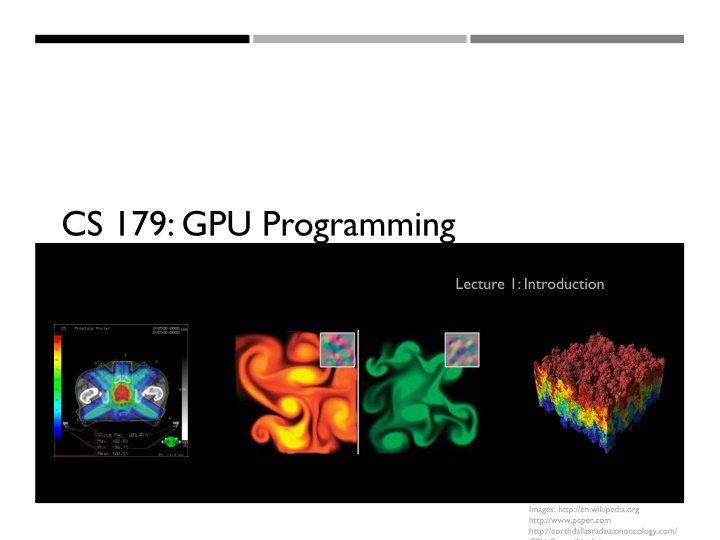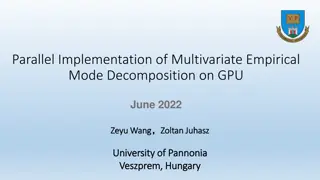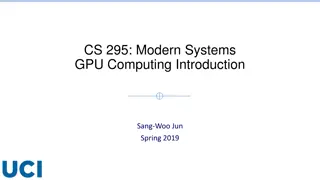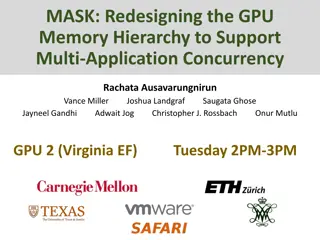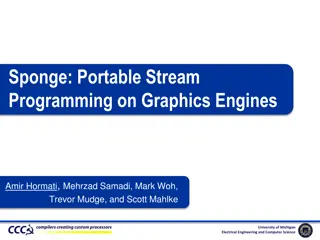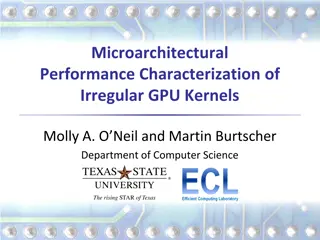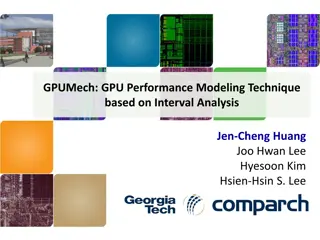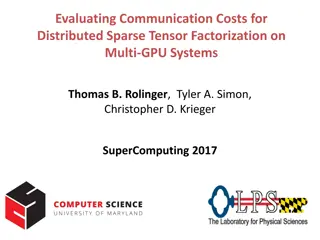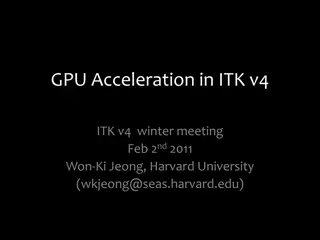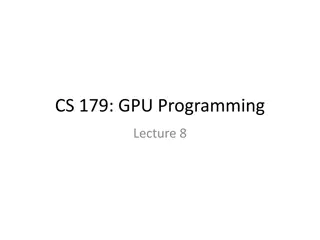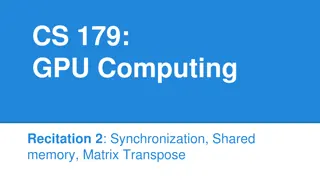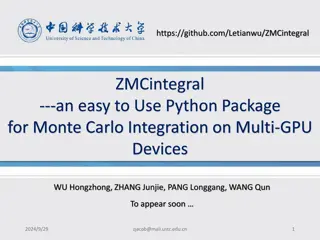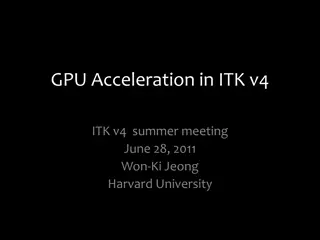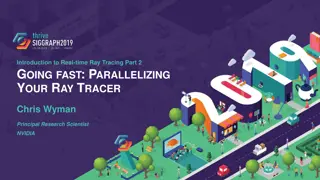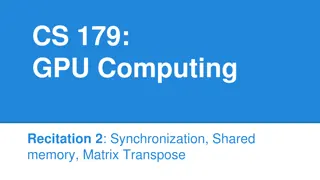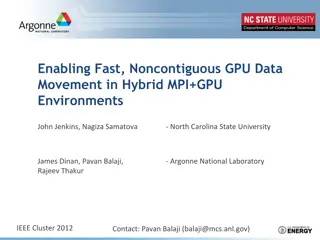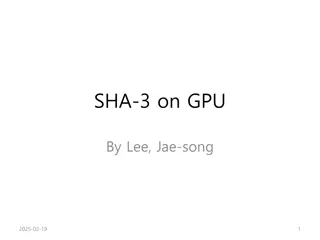GPU Programming Lecture: Introduction and Course Details
This content provides information about a GPU programming lecture series covering topics like parallelization in C++, CUDA computing platform, course requirements, homework guidelines, project details, and machine access for practical application. It includes details on TA contacts, class schedules, assignments, collaboration policies, and project options for students interested in learning GPU programming. The lecture aims to enhance students' skills in GPU computing and offers hands-on experience through assignments and projects.
Download Presentation

Please find below an Image/Link to download the presentation.
The content on the website is provided AS IS for your information and personal use only. It may not be sold, licensed, or shared on other websites without obtaining consent from the author.If you encounter any issues during the download, it is possible that the publisher has removed the file from their server.
You are allowed to download the files provided on this website for personal or commercial use, subject to the condition that they are used lawfully. All files are the property of their respective owners.
The content on the website is provided AS IS for your information and personal use only. It may not be sold, licensed, or shared on other websites without obtaining consent from the author.
E N D
Presentation Transcript
CS 179: GPU Programming Lecture 1: Introduction Images: http://en.wikipedia.org http://www.pcper.com http://northdallasradiationoncology.com/ GPU Gems (Nvidia)
Administration Covered topics: TAs: (GP)GPU computing/parallelization C++ CUDA (parallel computing platform) cs179tas@googlegroups.com for set submission and extension requests George Stathopoulos (gstathop@caltech.edu) Mary Giambrone (mgiambro@caltech.edu) Jenny Lee (clee7@caltech.edu) Website (course website is being updated): http://courses.cms.caltech.edu/cs179/ http://www.piazza.com/caltech/spring2019/cs179 Overseeing Instructor: Al Barr (barr@cs.caltech.edu) Class time: ANB 107, MWF 3:00 PM, attendance recommended but not required Recitations on Fridays
Course Requirements Fill out survey for class times and set submission: https://forms.gle/brBfBgvDv4voeERF9 Fill out this when2meet for office hours: https://www.when2meet.com/?7707636-okI5Y Homework: 6 weekly assignments Each worth 10% of grade Final project: 4-week project 40% of grade total P/F Students must receive at least 60% on every assignment AND the final project
Homework Due on Wednesdays before class (3PM) First set out April 3th, due April 10th Upcoming sets will use survey s due date Collaboration policy: Discuss ideas and strategies freely, but all code must be your own Do not look up prior years solutions or reference solution code from github without prior TA approval Office Hours: Located in ANB 104 Times: TBA (will be announced before first set is out) Extensions Ask a TA for one if you have a valid reason
Projects Topic of your choice We will also provide many options Teams of up to 2 people 2-person teams will be held to higher expectations Requirements Project Proposal Progress report(s) and Final Presentation More info later
Machines Primary GPU machine available Currently being setup. You will receive a user account after emailing cs179tas@googlegroups.com Titan: titan.cms.caltech.edu (SSH, maybe Mosh) Secondary machines mx.cms.caltech.edu minuteman.cms.caltech.edu These use your CMS login NOTE: Not all assignments work on these machines Change your password from the temp one we send you Use passwd command
Machines Alternative: Use your own machine: Must have an NVIDIA CUDA-capable GPU At least Compute 3.0 Virtual machines won t work Exception: Machines with I/O MMU virtualization and certain GPUs Special requirements for: Hybrid/optimus systems Mac/OS X Setup guide on the website is outdated. Follow NVIDIA s posted 2019 installation instructions (linked on page)
The CPU The Central Processing Unit Traditionally, applications use CPU for primary calculations General-purpose capabilities Established technology Usually equipped with 8 or less powerful cores Optimal for concurrent processes but not large scale parallel computations Wikimedia commons: Intel_CPU_Pentium_4_640_Prescott_bottom.jpg
The GPU The "Graphics Processing Unit" Relatively new technology designed for parallelizable problems Initially created specifically for graphics Became more capable of general computations
GPUs The Motivation Raytracing: for all pixels (i,j): Calculate ray point and direction in 3d space if ray intersects object: calculate lighting at closest object store color of (i,j) Superquadric Cylinders, exponent 0.1, yellow glass balls, Barr, 1981
EXAMPLE Add two arrays A[ ] + B[ ] -> C[ ] On the CPU: float *C = malloc(N * sizeof(float)); for (int i = 0; i < N; i++) C[i] = A[i] + B[i]; return C; This operates sequentially can we do better?
A simple problem On the CPU (multi-threaded, pseudocode): (allocate memory for C) Create # of threads equal to number of cores on processor (around 2, 4, perhaps 8) (Indicate portions of A, B, C to each thread...) ... In each thread, For (i from beginning region of thread) C[i] <- A[i] + B[i] //lots of waiting involved for memory reads, writes, ... Wait for threads to synchronize... This is slightly faster 2-8x (slightly more with other tricks)
A simple problem How many threads? How does performance scale? Context switching: The action of switching which thread is being processed High penalty on the CPU Not an issue on the GPU
A simple problem On the GPU: (allocate memory for A, B, C on GPU) Create the kernel each thread will perform one (or a few) additions Specify the following kernel operation: For all i s (indices) assigned to this thread: C[i] <- A[i] + B[i] Start ~20000 (!) 20000 (!) threads Wait for threads to synchronize...
GPU: Strengths Revealed Emphasis on parallelism means we have lots of cores This allows us to run many threads simultaneously with no context switches
GPUs Brief History Initially based on graphics focused fixed-function pipelines Pre-set functions, limited options http://gamedevelopment.tutsplus.com/articles/the-end-of- fixed-function-rendering-pipelines-and-how-to-move-on-- cms-21469 Source: Super Mario 64, by Nintendo
GPUs Brief History Shaders Could implement one s own functions! GLSL (C-like language), discussed in CS 171 Could sneak in general-purpose programming! Vulkan/OpenCL is the modern multiplatform general purpose GPU compute system, but we won t be covering it in this course http://minecraftsix.com/glsl-shaders-mod/
Using GPUs General-purpose computing on GPUs (GPGPU) Hardware has gotten good enough to a point where it s basically having a mini-supercomputer CUDA (Compute Unified Device Architecture) General-purpose parallel computing platform for NVIDIA GPUs Vulkan/OpenCL (Open Computing Language) General heterogenous computing framework Both are accessible as extensions to various languages If you re into python, checkout Theano, pyCUDA.
GPU Computing: Step by Step Setup inputs on the host (CPU-accessible memory) Allocate memory for outputs on the host Allocate memory for inputs on the GPU Allocate memory for outputs on the GPU Copy inputs from host to GPU Start GPU kernel (function that executed on gpu) Copy output from GPU to host NOTE: Copying can be asynchronous, and unified memory management is available
The Kernel Our parallel function Given to each thread Simple implementation:
Indexing Can get a block ID and thread ID within the block: Unique thread ID! https://cs.calvin.edu/courses/cs/374/CUDA/CUDA-Thread-Indexing-Cheatsheet.pdf https://en.wikipedia.org/wiki/Thread_block
